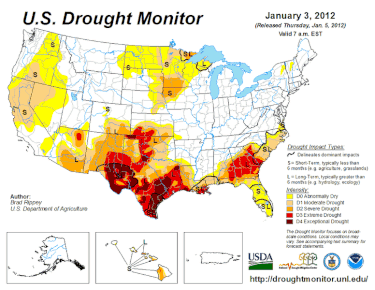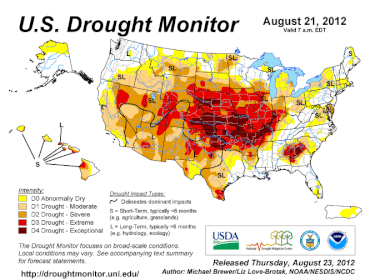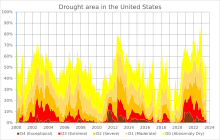| The factual accuracy of parts of this article (those related to article) may be compromised due to out-of-date information. Please help update this article to reflect recent events or newly available information. (January 2013) |

 The U.S. Drought Monitor on August 21, 2012.
The U.S. Drought Monitor on August 21, 2012. A map showing the drought in Eastern Canada.
A map showing the drought in Eastern Canada.
The 2012–2013 North American drought, an expansion of the 2010–2013 Southern United States drought, originated in the midst of a record-breaking heat wave. Low snowfall amounts in winter, coupled with the intense summer heat from La Niña, caused drought-like conditions to migrate northward from the southern United States, wreaking havoc on crops and water supply. The drought inflicted significant economic ramifications for the affected states. It exceeded, in many measures, the 1988–1989 North American drought, the most recent comparable drought.
The drought affected most of the U.S., parts of Mexico, and central and Eastern Canada. At its peak in July 2012, it covered approximately 81 percent of the contiguous United States with at least abnormally dry (D0) conditions. Out of that 81%, 64% was designated as at least moderate drought (D1) conditions. Its area was comparable to the droughts in the 1930s and 1950s.
Drought continued in parts of North America through 2013. Beginning in March 2013, improved rainfall across the Midwest, southern Mississippi Valley, and Great Plains began gradually alleviating drought in these areas, while drought continued to intensify in the Western United States. Heavy rains across previously drought-stricken areas resulted in widespread flooding in portions of the Midwest, a phenomenon which was named "weather whiplash". By June 2013, approximately the eastern half of the United States was drought-free, while conditions continued to gradually improve across the Plains. Moderate to severe drought continues to impact and worsen throughout the western United States, with some portions of the United States being afflicted by the drought for over three years. Through the winter of 2013–2014, California continued to receive record low rainfall. For many locations, the calendar year of 2013 was the driest year in over 130 years. Some locations received less than half of their previous record low rainfall amounts.
Meteorological background

The drought was set in motion when strongly positive Arctic oscillation and North Atlantic oscillation conditions removed winter storms from the U.S. the winter of 2011–2012. When spring arrived, very little snow existed to melt and moisten the ground, and thus very little water to evaporate and create rainfall. The effects of the lack of snow were immediate. Dry conditions could be noticed immediately, and contributed to a weak tornado season in the U.S. The strongest tornado outbreak of 2012 occurred on March 2, after most snow had melted. The drought continued to steadily intensify along with a decline in rainfall which is still ongoing. The Summer 2012 North American heat wave caused further evaporation of groundwater, lakes, reservoirs, and rivers and streams.

As moisture has continued to decline, the conditions are becoming self-sustaining (i.e. a lack of rainfall means that less moisture is available to promote additional rainfall, in a vicious cycle). In many areas, the only way for drought conditions to be significantly alleviated in the short-term would be for a discrete, long-lived, and large system (such as a tropical cyclone) to impact the area. Soil hardening due to the drought means that even if a large amount of rain falls in a short time, most of it will run off quickly causing flash floods rather than drought relief. The June 2012 North American derecho and other strong storms in late June and early July did not appear to ease drought conditions, as the rainwater ran off rapidly from the affected areas.
The drought continued and intensified into the end of November 2014 for a large part of the country. Although drought/dry conditions are likely to drop at least one category level in the Southwest, Southeast, Northeast, and Northern Plains as well as portions of the Ohio River Valley, it is expected to have both short-term and long-term impacts across nearly the entire affected area.
A study by Utah State University analyzed the 2011 Missouri River Flooding and predicted that "a prominent teleconnection forcing in driving the wet/dry spells in the (Missouri River Basin)... implies persistence of dry conditions for the next 2 to 3 years", which coincides with the 2012–15 drought. That analysis was based upon a marked variability at the 10–15- year time scale that is coincident with the water storage increase in the Missouri River Basin. The study found that precipitation over the MRB undergoes a profound modulation during the transition points of the Pacific quasi-decadal oscillation and associated teleconnections.
Impacts
United States

The drought cost more than $35 billion in the Midwest, and may have reduced the gross domestic product by 0.5–1% of the U.S. as a whole, equating to a loss of $75 to $150 billion.
Crops, particularly strains grown in the most heavily affected regions (such as corn and soybeans), were noted to be failing or yielding very low in 2012 due to the drought's presence in farming areas. This increase in cost moved up the feeding chain and resulted in raised prices for meat, dairy, and processed food products.Food prices increased as a result of the consequent supply shortfall. The price of farm equipment, on the other hand, decreased as farmers were forced to sell off their equipment and machinery to cope with decreased incomes.
Water levels on parts of the Mississippi River plummeted, affecting trade and commerce.
1,692 counties across 36 states in the U.S. were legally declared primary natural disaster areas in August 2012 as the drought covered over 62% of the contiguous U.S. Hundreds of additional counties bordering the primary disaster areas were designated as "contiguous" disaster areas, and are also eligible for federal aid.
The number of cattle in the U.S. decreased to the lowest in 60 years due to drought impacts, with 69% of cattle located in areas that faced drought conditions.
California
Main article: 2011–2017 California drought
California had been experiencing a drought since 2011. In 2013 the total rainfall was less than 34% of what was expected. Many regions of the state accumulated less rainfall in 2013 than any other year on record. As a result of this, many fish species were threatened. Streams and rivers were so low that fish couldn't get to their spawning grounds, and survival rates of any eggs that are laid were expected to be low. Lack of rainfall had caused the mouths of rivers to be blocked off by sand bars which further prevents fish from reaching their spawning grounds. Stafford Lehr, Chief of Fisheries within the California Department of Fish and Wildlife says that 95% of winter run salmon didn't survive in 2013. Not only did the drought severely affect fishing, but also agriculture. Decreasing rainfall amounts and increasing temperatures cause agriculture to be much more challenging due to increasing rates of evapotranspiration.
In response to heightening drought conditions, California tightened fishing restrictions in many areas of the state. Streams and rivers on the northern coast had unprecedented amounts of fishing bans. In February 2015 the California Fish and Game Commission voted unanimously to further tighten regulations on both recreational and commercial fishing. The U.S. Endangered Species Act listed steelhead as threatened and coho salmon as endangered. The California Department of Fish and Wildlife closed dozens of streams and rivers to fishing in 2014. Lehr said that he fears coho salmon may go completely extinct south of the Golden Gate Bridge in the near future. In early 2014 the main stems of the Eel, Mad, Smith, Van Duzen, and Mattole rivers were closed pending additional rainfall. Large areas of the Russian and American rivers were closed indefinitely. Most rivers in San Mateo, Santa Cruz and Monterey counties were also closed pending further rainfall. Other actions were also taken, such as releasing more water from the Kent Dam in hopes of raising the levels in the Lagunitas Creek watershed – one of the last spawning grounds that wild coho can still reach.
Protesters said that banning fishing will disrupt the economy and threaten the livelihoods of individuals who rely on salmon fishing during the winters. Officials felt that it will help prevent species that are already in trouble from slipping to extinction.
Canada
The drought affected Canada mainly in the east in Ontario, Quebec, and the Atlantic provinces where there was record setting heat and very little rainfall. Summer crops in these areas were affected and the price of produce, particularly corn and soybeans, was expected to increase.
See also
Concurrent and related weather events
- Summer 2012 North American heat wave
- June 2012 North American derecho
- 2012 Oklahoma wildfires
- 2012 Colorado wildfires
- Climate change in California
- 2013 California wildfires
- 2014 California wildfires
- 2015 Puerto Rican drought
Other widespread severe droughts
References
- Freedman, Andrew (21 July 2012). "Causes Of Midwest Drought: La Nina And Global Warming Thought To Contribute To Dry Weather". Huffington Post. Retrieved 14 January 2013.
- Kimery, Anthony (January 6, 2012). "FEMA – Dealing with the Drought". Homeland Security Today. Archived from the original on December 25, 2011. Retrieved 2012-08-24.
- "Map Archive - July 17, 2012". droughtmonitor.unl.edu. Retrieved 2019-12-22.
- "July 17, 2012". DroughtMonitor.UNL.edu. United States Drought Monitor. Retrieved August 9, 2016.
- Parry, Wynne (19 July 2012). "How Bad Is the US Drought?". LiveScience. Yahoo! News. Retrieved 19 July 2012.
- Mcwhirter, Cameron (March 12, 2013). "Rains Bring Relief to Region; Winter Weather Reduces Drought in Southeast, Southwest; Other Areas Still Threatened". The Wall Street Journal.
- Thin Snowpack in West Signals Summer of Drought February 22, 2013 The New York Times
- "As Drought Turns To Flood, Farmers Get 'Weather Whiplash' : The Salt". NPR. 2013-06-12. Retrieved 2014-03-03.
- Becerra, Hector (September 25, 2014) "Drought has 14 communities on the brink of waterlessness" Los Angeles Times
- In Midwest, Drought Gives Way to Flood April 25, 2013 New York Times
- "So far, Arctic Oscillation favoring mild winter for eastern U.S." Climate.gov. 21 December 2011. Retrieved 17 September 2014.
- Freedman, Andrew (28 July 2012). "Tornado Season 2012: Record-Low Twister Count Is Drought's Silver Lining". The Huffington Post. Retrieved 14 January 2013.
- Samenow, Jason (5 March 2012). "Tornado outbreak: recap of deadly March 2 storms in Tennessee and Ohio Valley, South". The Washington Post. Retrieved 14 January 2013.
- Freedman, Andrew (9 July 2012). "2012 Heat Wave is Historic, if not Unprecedented". Climate Central. Retrieved 14 January 2013.
- Painter, Bryan (7 August 2011). "Dryness, heat make for vicious cycle". NewsOK. Retrieved 14 January 2013.
- "Drought Termination and Amelioration". National Climatic Data Center. Retrieved 14 January 2013.
- "United States Drought Monitor > Home". DroughtMonitor.UNL.edu. Retrieved 2014-03-03.
- "United States Drought Information". Climate Prediction Center. Retrieved 17 September 2014.
- ^ Wang, Shih-Yu (2014). "The Pacific quasi-decadal oscillation (QDO): An important precursor toward anticipating major flood events in the Missouri River Basin?" (PDF). Geophysical Research Letters. 41 (3): 991–997. Bibcode:2014GeoRL..41..991W. doi:10.1002/2013GL059042.
- "Video Gateway: Teleconnection and the buildup of water storage leading to the 2011 Missouri River flooding". ams.confex.com.
- Masters, Jeff. "Dr". Weather Underground. Retrieved 13 January 2013.
- Crutchfield, Steve. "U.S. Drought 2012: Farm and Food Impacts". USDA ERS. Archived from the original on 16 January 2013. Retrieved 13 January 2013.
- Drought Stalks the Global Food Supply, Business Week July 5, 2012
- Severe Drought Seen as Driving Cost of Food Up July 25, 2012 The New York Times
- World Magazine "Our Parched Land" August 11, 2012 Daniel James Devine (author)
- MCWHIRTER, Cameroon (13 July 2013). "Trade Dries Up Along With Mississippi". Wall Street Journal. Retrieved 19 July 2012.
- AP (2012-08-01). "U.S. drought: Half of all counties disaster areas". CBS News. Retrieved 2014-03-03.
- Mark Peters (2 February 2013). "Drought Drives Down Cattle Count". WSJ.
- Drought on the Range: Tough Times for U.S. Cattle Herd – 2013 – The New York Times. YouTube. 11 April 2013.
- Hickey, Brian (February 5, 2014). "Calif. bans fishing on more rivers due to drought". KCRA.Com. KCRA. Retrieved May 25, 2015.
- Moseley, William (2014). An Introduction to Human-Environment Geography. Chichester, West Sussex, UK: Blackwell Publishing. p. 206. ISBN 978-1-4051-8931-6.
- ^ Kinney, Aaron (February 5, 2014). "Historic fishing ban expanded by California wildlife officials". San Jose Mercury News. Retrieved May 25, 2015.
- ^ Clarke, Chris (January 28, 2014). "Drought May Already Have Killed Off Central Coast Coho Salmon". KCET. Retrieved May 25, 2015.
- ^ "Record crop prices spur food-crisis worries". CBC News. July 20, 2012. Retrieved 2014-03-03.
- Drying times; The 2012 drought will dent farm profits and push up food prices July 21st 2012 The Economist
External links
- Annual Drought Report for 2012, National Climatic Data Center, National Oceanic and Atmospheric Administration (NOAA)
- National Drought Mitigation Center
- Lifestyles of the Rich and Parched – How the Golden State’s 1 percenters are avoiding the drought, Politico magazine
- Droughts in North America
- 2012 natural disasters in the United States
- 2013 natural disasters in the United States
- 2014 natural disasters in the United States
- 2015 natural disasters in the United States
- 2012 in Mexico
- 2013 in Mexico
- 2014 in Mexico
- 2015 in Mexico
- 2012 disasters in Canada
- 2013 disasters in Canada
- 2014 disasters in Canada
- 2015 disasters in Canada
- Natural disasters in Mexico
- 2010s meteorology
- Droughts in the United States
- Droughts in Canada
- 2012 droughts
- 2013 droughts
- 2014 droughts
- 2015 droughts